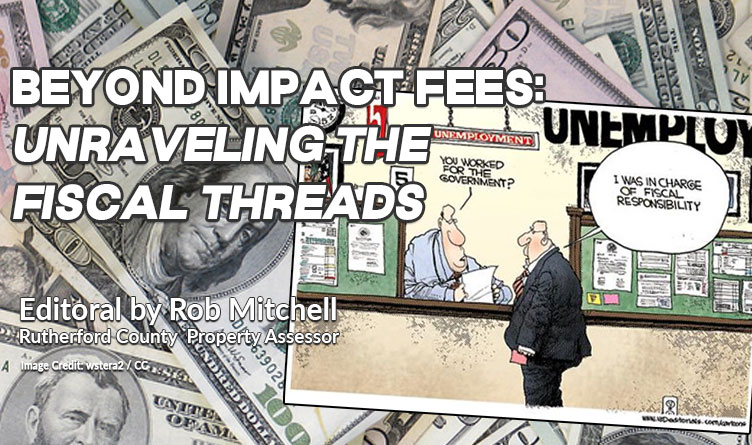By Rob Mitchell [Rutherford County Assessor of Property] –
In Tennessee’s thriving counties, growth is more than a statistic; it’s a living, breathing force reshaping communities.
Rutherford County, a prime example of this trend, experienced a remarkable 2.68% growth spurt from 2021 to 2022. But behind these impressive numbers lies a complex narrative about fiscal responsibility, one that demands closer examination.

Unveiling the Fiscal Tapestry:
Rutherford County’s 2023 property tax rate stands at $1.88, overseeing a total assessed value for taxation exceeding $15 billion. The county boasts a diverse community with over 137,000 taxable parcels and a population exceeding 365,150. However, this numerical snapshot only reveals a fraction of the story.
The county budget, a staggering $849.8 million, is an intricate web woven from allocations, responsibilities, and community needs. Property taxes contribute significantly, amounting to $285.8 million. But here’s where the narrative takes a fascinating turn.
The Property Tax Burden and Beyond:
On average, Rutherford County property owners bear a burden of $2,082 per parcel and $2,327 per person. While these figures might seem reasonable at first glance, the total tax burden per parcel rings in at a significant $6,190.
This disparity begs the question: what accounts for the $4,108 difference between total taxes and property taxes per parcel?

Across the County Lines:
Let’s widen our lens and examine neighboring counties like Knox, Montgomery, Wilson, and Hamilton. Each has experienced its own unique growth trajectory, weaving its own intricate financial tapestry.
Montgomery County, boasting a commendable 3.23% growth rate, operates with a property tax rate of $2.99. Its budget of $567.8 million is supported by $161.5 million in property taxes.
Residents shoulder an average property tax burden of $1,763 per parcel and $2,422 per person, contributing to a total tax burden of $6,200.
However, mirroring the trend in Rutherford County, there exists a substantial $4,436 gap between property and total taxes per parcel.
This pattern echoes across these vibrant counties. While the growth narrative is undeniable, the fiscal decisions guiding this growth demand a closer look.
Beyond Impact Fees:
Perhaps the most critical issue isn’t the presence or absence of impact fees, but rather the prudent utilization of community resources. Often touted as the solution, impact fees are merely one thread in the intricate fabric of county finances.
As we navigate the complexities of county finances, it’s evident that the challenge lies not solely in implementing or avoiding impact fees.
Instead, it’s about ensuring that every dollar spent aligns with the community’s needs and growth trajectory. The real struggle lies in making judicious decisions that balance growth with fiscal responsibility.

A Call to Action:
The numbers tell a compelling story, and it’s not just about growth. It’s about how we manage that growth. Fiscal responsibility should be the guiding principle, ensuring that our communities thrive not just today, but for generations to come.
Join the conversation as we delve deeper into how these counties grapple with the consequences of their fiscal decisions and explore potential pathways towards a more financially resilient future.
Together, we can unravel the threads of fiscal responsibility and weave a brighter future for all.



